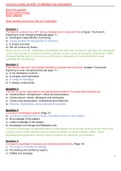THIS IS A GUIDE ON HOW TO ANSWER THE ASSIGNEMT
Red is the question
Blues possible answer
Green abstract
Read carefully and ensure that you understand.
Question 1
The field of curriculum is a 20th century development in education that (chapter 1Curriculum:
Exploring an ever-changing landscape page 11)
a) Developed independently of schooling.
b) Closely parallel the development of schooling.
c) Is simple and clear.
d) Did not involve any theory.
While courses of study, categories of knowledge and skills have existed for centuries, the emergence
of curriculum as social construct and field of study is a fairly recent development. MacDonald (1992)
contends that the field of curriculum is a 20th century development in education that closely
paralleled the development.
Question 2
Peter Ramus was one if the earliest theorists to propose that curriculum (chapter 1Curriculum:
Exploring an ever-changing landscape page 11)
a) Is not necessary in school.
b) Is complex and interrelated.
c) Is a map of knowledge.
d) Is always constructivist.
Question 3
The four curriculum approaches and perspectives studied in the prescribed textbook are
a) Constructivism, interpretivism, critical and structuralism.
b) Constructivism, critical, ideological and ontological.
c) Critical, post-structuralism, interpretivist and modernist.
d) Positivist, interpretivist, critical and post-structuralism.
Question 4
Curriculum knowledge presents (Page 21)
a) A particular selection from a range of possible choices on that subject.
b) All knowledge of the subject.
c) Latest knowledge of the subject.
d) Knowledge from Google and Wikipedia only.
Curriculum knowledge, as discussed above, is developed into structured curricula as we have come
to know it and is often referred to as the explicit or written curriculum (Wilson, 2005). This is
developed and organized in terms of various systems for education and schooling.
Question 5
Curriculum knowledge is typically and incorrectly presented as (Page 19)
a) The same as everyday knowledge.
b) Pre-existing and verified by experts
c) Fallible and changing.
1
, d) Created by ordinary people.
Curriculum knowledge is assumed to be different from everyday knowledge and best studied apart
from everyday experience and general world knowledge.
Question 6
Pinar suggests that curriculum knowledge should be (Page 21)
a) Presented as unchanged and verified.
b) Distant from students’ own experiences.
c) Enabling and not alienating.
d) As uninteresting as possible.
Pinar (2004: xv) asserts that the key question remains: What knowledge is of most worth? He
suggests that this is animated by ethics, history and politics and remains an on-going question. He
indicates that an important aspect of curriculum processes is to link the planned curriculum to the
lived curriculum and to demonstrate to children that scholarship can speak to them and that
scholarship can enable them to speak. His suggestion, in short, is that curriculum knowledge should
be enabling and not alienating, and that it needs to be mediated in terms of current living and life
circumstances.
Question 7
Three kinds of policy according to Connolly and Connolly are (Page 22)
a) Ontological, epistemological and axiological
b) Flexible, inflexible and neutral.
c) Active, passive and orderly.
d) Formal, implicit and prudential.
Three kinds of curriculum policy can be distinguished according to Connelly and Connelly (2010:227):
formal, implicit and prudential.
Question 8
According to Gough, the term content, seems to indicate that a curriculum is (Page 23)
a) Like a container.
b) Prescribed and defined.
c) Like a manufacturing industry.
d) Not defined by its content.
Furthermore, many of these components and the spaces they occupy have been conceptualized as
mate rial objects. Gough (1999:50) suggests that the term 'content' seems to indicate that curriculum
is like a container (an object with bounded spatial dimensions), while reference to frameworks,
standards and flow charts used to depict planning sequences invoke the technical languages of
manufacturing industries.
Question 9
According to Gough, references to words such as: framework, standards and flow charts when
referring to curriculum, suggest (Page 23)
a) A stable output is certain in teaching.
b) Technical language used in the manufacturing industry.
c) A flexible document.
d) An accurate representation of reality.
Furthermore, many of these components and the spaces they occupy have been conceptualized as
mate rial objects. Gough (1999:50) suggests that the term 'content' seems to indicate that curriculum
is like a container (an object with bounded spatial dimensions), while reference to frameworks,
2|Page




